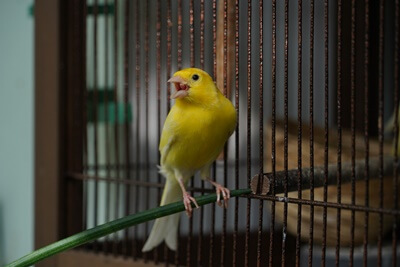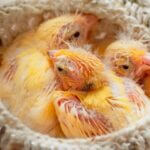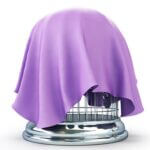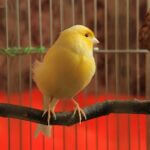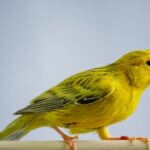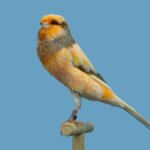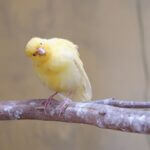Canaries have a large, horizontal field of view due to the position of their eyes. Eye positioning determines whether an animal will have binocular or monocular vision.
Animals with binocular vision have eyes that are close together at the front of their face. The proximity of their eyes enables them to focus on a single object and determine the depth of the object in the scene.
This is useful for hunting and calculating how far the prey is. That’s why birds of prey like falcons, eagles, and hawks have their eyes so close together.
Canaries are forager birds and don’t need to calculate how far away something is to chase it down, which is why they have one eye on each side of their head.
Having eyes so far apart gives them monocular vision, meaning they can see most of what’s around them without turning their head. Not only does this help them forage for food, but it also helps them see when predators are nearby.
Because of their monocular vision, canaries have a horizontal field of view of 300 degrees, which is only 60 degrees short of a complete circle. They have a small blind spot at the back of their heads.
How Far Can Canaries See?
Researchers rarely ever explore the topic of forager birds as they do birds of prey, most likely because canaries’ eyesight isn’t as impressive.
Some people believe that songbirds like canaries are nearsighted because they don’t hunt, but there isn’t enough evidence.
Can Canaries See Color?
Canaries have 4 color receptors, while humans have 3 color receptors. So, canaries can see more colors than humans. Color receptors are a type of cell in our retinas, an eye tissue that responds to light.
The first 3 color receptors enable canaries to see primary colors (red, green, and blue). They can also see all the combinations these 3 colors can produce, including purple, yellow, and orange.
The 4th color receptor helps them see ultraviolet, a color invisible to the human eye.
Why Can Canaries See Ultraviolet?
Canaries can see ultraviolet light because it enables them to survive more efficiently. They primarily detect ultraviolet for three reasons:
- Mate selection
- Foraging
- Caring for their young
Many canary species lack sexual dysmorphism, so it’s hard to tell if they’re male or female at first glance. However, canaries of different sexes have distinct plumages that can be seen when illuminated with ultraviolet light.
Canaries use their ability to see ultraviolet to differentiate between males and females and pick mates. The color of their plumage helps them determine who will make a healthy mate, and those with the most vibrant ultraviolet plumage have more mating success.
According to Nature Communications, birds that can see ultraviolet are better foragers. Ultraviolet light elevates the contrast between different colors, so canaries can differentiate between the green foliage and the different colored fruits from a distance.
When caring for their young, mother canaries will use ultraviolet light to determine which hatchlings to prioritize. The underweight hatchlings reflect ultraviolet light more than healthy ones, so those are the hatchlings the mothers feed first.

Do Canaries Have Better Vision Than Humans?
When it comes to light frequencies, canaries excel. According to Uppsala University, they can detect light faster than humans because birds have a higher critical flicker-fusion frequency (CFF).
When the speed of light waves exceeds our CFF, we perceive the light as solid and continuous. We see the light flickering if the waves are slower than our CFF.
Forager birds like canaries have a higher CFF than humans because it helps them detect rapid movement better. This helps when watching out for predators.
However, the ability to detect light faster comes at the cost of spatial resolution, which is the ability to see things clearly from afar.
Can Canaries See Infrared Light?
Canaries can only detect light with a wavelength below 700 nanometers, so they can see infrared light.
Invisible lights like gamma rays, microwaves, and infrared have wavelengths over 780 nanometers. The wavelengths are too long and slow for the cells in canaries’ eyes to detect.
Do Canaries Have Night Vision?
Canaries didn’t develop good night vision because they’re diurnal, which means they’re active during the day and go to sleep at night.
Animals with excellent night vision (like cats and owls) hunt at night. They need to be able to see in the dark to eat and survive, but canaries don’t need to see well at night.
The number of photoreceptors in an animal’s retinas determines how well they can see in the dark. The rod photoreceptor is the one that helps canaries detect changes in light.
It isn’t known exactly how many rods canaries have in their eyes. Humans have roughly 91 million rods, and our night vision is terrible. So, it can be assumed that canaries have about the same amount.
Do Canaries Have Eyelids?
Canaries have two horizontal eyelids covering the top and bottom of the eyes. Also, they have a third eyelid (nictitating membrane) that sweeps across the eye vertically.
Given how much the wind dries out the eyes, canaries have to blink while flying. However, they can’t constantly close their eyes, or they couldn’t watch where they’re going.
So, they use their nictitating membrane instead of the other two eyelids. This way, they can keep their eyes moisturized without compromising their sight.
Hatchlings are born blind, so when it’s time for their mother to feed them, they accidentally poke at her face as they reach for the food. She covers her eyes with the nictitating membrane to protect them from her hungry hatchlings’ sharp beaks and claws.
Canaries use their nictitating membrane when they fear they’re in danger. They focus on their surroundings to see if they can spot a predator and keep their eyes open. When their eyes dry out, they use their nictitating membrane to keep it moisturized without closing their eyes.
You can’t see the eyelids on canaries because they’re covered in feathers.
These eyelids serve two vital functions:
- To keep the eyes moisturized
- Keep debris out of the eyes
Having dry eyes impairs a canary’s vision. While foraging, the canaries will blink to keep things crystal clear and have an easier time searching for food.

